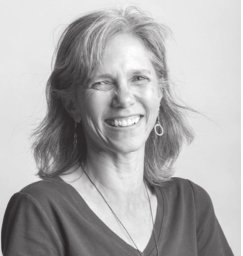Driving past a billboard with the word “Think” on it, Jessica Kovan’s mind immediately begins to play with the word. This week’s cover artist sketches it out mentally, slowly planning the piece that was inspired by the word.
“It’s rare that a painting of mine doesn’t have some type of writing in or under it,” Kovan said. “Even if it’s in the glue, and you can’t see it, it’s always there.”
Kovan’s piece gracing the cover of this issue is no different. Hidden under the layers of paint and glue is text Kovan wrote on the canvas before painting over it.
The piece, “Blue,” was inspired by the Shel Silverstein poem “Masks.”
“To me, it is a poem reflecting the fact we all wear masks,” Kovan said. “And in doing so, we don’t really see each other. We potentially miss the opportunity to truly know each other.”
Growing up with a mother as a teacher, before becoming earning a Ph.D. in adult education, Kovan said literature is one of her biggest influences.
Kovan’s work has been published in several books, including “Art Journal Kickstarter: Pages and Prompts to Energize your Art Journals,” “The Poetry of Presence” and “The Best of Mixed Media: The Art of Storytelling.”
What’s the difference between being a teacher of art and being a full-time artist?
It’s two very different parts of my brain. When I paint, I paint conceptually and from an emotional side to try to get my story and feelings across. When I teach, I have to also teach methods and technique while incorporating the emotional side. I have to teach them how to capture a piece of creativity.
Your artist biography describes your art as “thoughtful, storytelling and layered.” Why would someone describe your art like that?
I paint stories. Like the piece, “Blue,” is from a poem. Music also inspires me, so I try to tell that within a painting. There’s more than what’s within the surface. I try to pull people in, which is why there’s also an emotional component. My paintings are always layered and often include glue, so there’s many layers so you can look at them as many times as you’d like and find something new. Everyone interprets my pieces differently.
You said everyone may interpret “Blue” differently. What ways do you think it can be interpreted?
If you look at the poem, it’s talking about the mask people wear. But if you don’t read the poem and see the painting, you could interpret it as family. You can interpret it entirely different depending on if you’ve read the poem or not. Honestly, a person doesn’t even have to read the poem — just the fact it intrigues you and makes you think more about it is good. It’s about a sense of community and how we all fit together. Are we actually listening to each other? Walking side-by-side to each other? Are we working together? There’s all these pieces in the paining.
How did you take a poem and turn it into a painting?
That’s just what I love to do. My daughter just gave me a playlist for my birthday that she does every year, and we were just listening to it. It’s titled “On the Brink of Everything.” All the songs on it are about that theme. I was listening to these songs and there were so many great lyrics that I wanted to create a painting to. Song after song, I wanted to create a painting. That’s how I work. I’ll hear something and then I need to create it. Then I’ll be thinking how I can create an image and capture that in a painting. It’s the way I’m inspired to create. Everyone has a different way, but words and phrases capture my feelings. Then I start working.
Why do words influence your art so strongly?
I don’t know. Maybe it’s the way I’m wired. I love words and phrases. It’s funny because I try to think of some of the words I heard earlier that inspired me but I can’t now. There’s phrases everywhere. We are constantly bombarded by words, so how could I not be inspired?
Support City Pulse - Donate Today!
Comments
No comments on this item Please log in to comment by clicking here